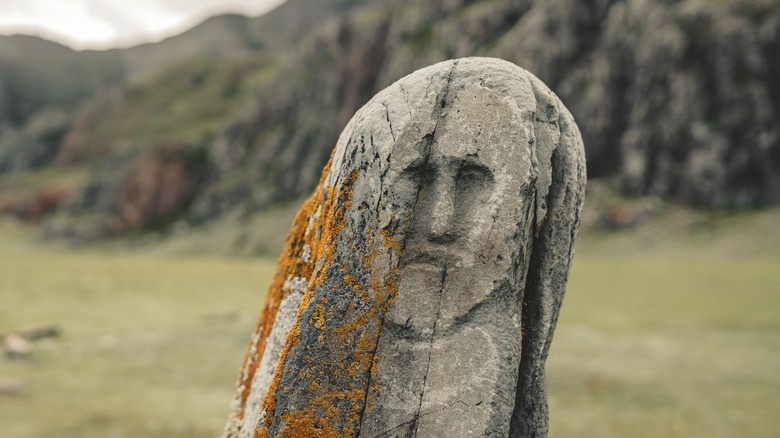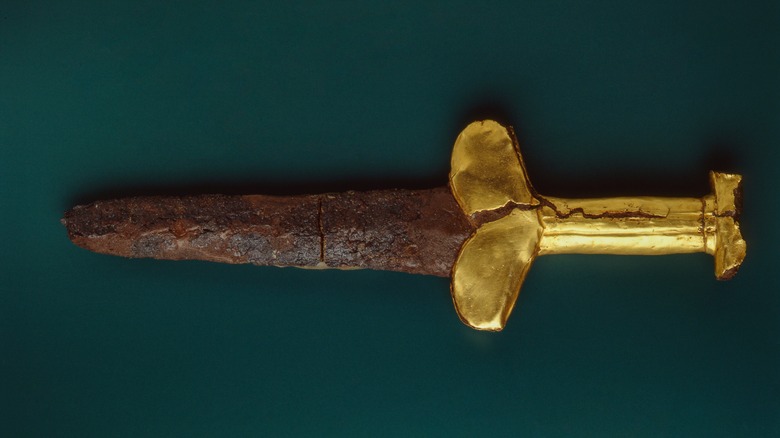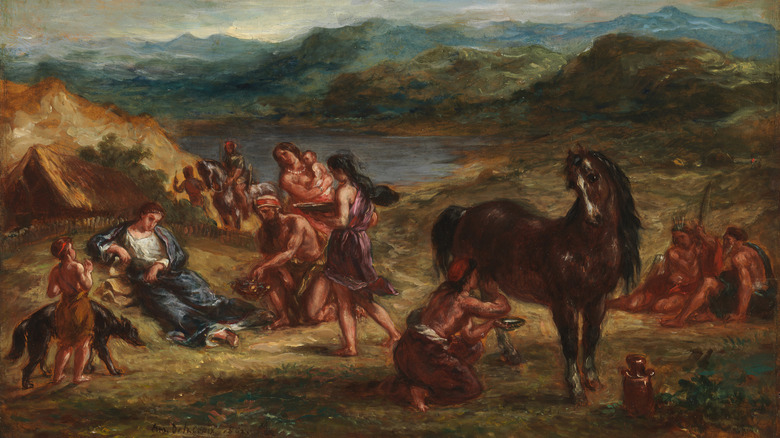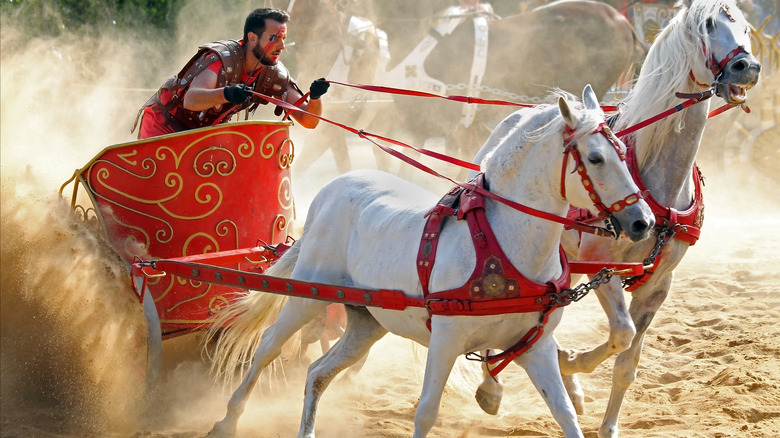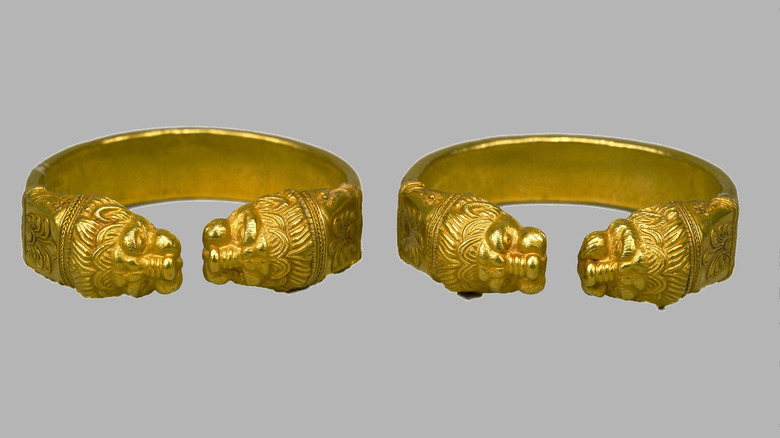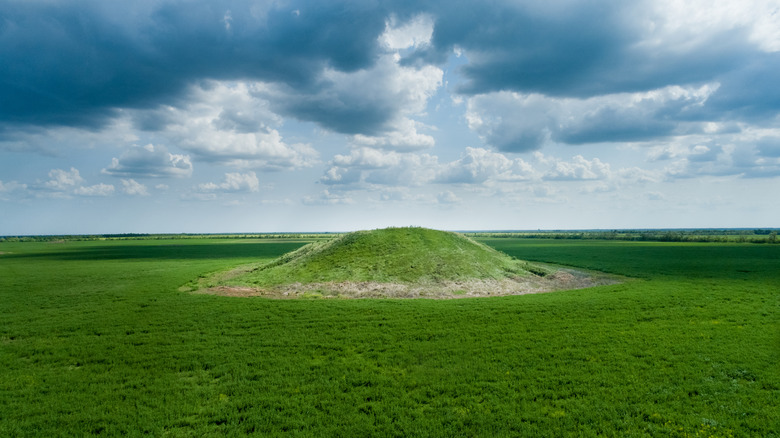The Tragic, Brutal Fate Of The Wife And Servants Of A Scythian King
Living as nomads, the men and women of the Scythians were known to be fierce warriors who rode on horseback into battles during the fourth century B.C. While women were on equal footing as men, their community was separated into groups of royals and commoners (via World History). Royal Scythians were adorned in gold and lived a lavish lifestyle, and in death, they were just as materialistic. That, along with their belief in what lay ahead in the afterlife meant that they were taking their precious things with them, including other human beings.
CBE International reports that Scythian Kings were buried in large mounds that could easily reach 65 feet tall and more than 300 feet in circumference. But time took its toll and wore the mounds down to the point where Russian farmers spent centuries plowing over the burial grounds, with no idea what lay underneath (via Daily Mail). Some of the graves have been discovered as recently as 2015, giving scientists a good look at one of the Scythians' most sacred burial rites.
Amazon women
While gender roles in this society tended to value men and women as equals, there was a different sort of hierarchy (via World History). The class groups included royals and farmers and the society as a whole worked together as a community, moving often from place to place. Per CBE International they're thought to have originated near modern-day Siberia and wandered west toward Europe. Royal Scythians didn't live in big castles or hoard their wealth. Instead, they rode on horseback to get between destinations, some using covered wagons as their primary residences.
When there was conflict, both males and females fought. Smithsonian Magazine reports that about a third of Scythian women took their weapons to the grave, and many of them had battle scars to prove they had fought bravely. And in Scythian culture, if women died in battle, they had their own elaborate burials. In some of the unearthed graves from around the fourth century B.C., the women's bodies were sat upright, as if they were riding a horse, to show their high status and power. In fact, Scythian women warriors were so feared that we still talk about them today — they're sometimes referred to as "Amazons" (via World History).
Scythian society
But this society didn't treat everyone equally. Per CBE International, there is evidence that enslaved servants were often Black or Greek, and were crudely referred to as "sun-burnt" or "barbarians" to set them apart from white Scythians.
World History reports that women who weren't warriors usually lived in colorful, elaborately decorated wagon homes with their families. They occupied their days with caring for the animals they herded, making weapons or crafts, or going out to trade goods or hunt.
Per CBE International, the Scythians believed strongly in the afterlife and prepared for it during their time on Earth. But that was bad news for those around a Scythian King. After the king died, his spouse would be killed in order to accompany him to the next life. His personal servants could be killed, too.
According to ancient Greek historian Herodotus, in one case, a year after a Scythian King's death — and his wife and some of his servants killed and buried with him — 50 more servants went on horseback to the king's resting spot (via CBE International). These servants and the horses they rode were also slain and buried with the king in order to serve him in the afterlife.
The value of horses
The horses weren't buried alive — they were usually killed and eaten in an elaborate funeral banquet (via CBE International). These feasts could be absolutely enormous. At one funeral, more than 1,300 people attended. To feed the massive crowd 35 horses, two deer, and 14 wild boars were feasted on before the remains were buried.
One of the biggest known Scythian burial sites was uncovered in the 1970s. This site was found in the Arzhan Kurgan, a swampy area of the Tuva Republic in Russia (per Science Direct). At this site, a chieftain leader had been buried with his spouse and at least 15 of his staff members (via CBE International). About 150 horses trotted into the afterlife with them.
According to the Daily Mail, horses were considered highly valuable in those days, so it was important for a king to bring them along with him. Iranica Online reports that the horses might even be hooked into their chariots before being killed and buried in the grave.
Scythians loved gold
Per World History, it wasn't exactly a surprise to a Scythian King's wife that she would be going to the afterlife with her husband — the carefully built tombs had wooden chambers to house the couple. It seems like they tried to make their final resting place comfortable with brightly colored blankets and rugs. They even thought to include toiletries, like hair combs and mirrors, so that the couple could look their best. Both men and women often had pierced ears and would bring along gold earrings and necklaces. Of course, they also brought along their finest clothes and tall gold headdresses.
If you served the royal Scythians, you might be out of luck if your overlord died (via CBE International). There was about a one in three chance that servants would be killed and buried with the king they served. One particularly grim example was found in a 2,500-year-old Scythian gravesite named Kazanovka 6 (via Daily Mail).
A servant's tragic fate
The Russian grave called Kazanovka 6 contained a young couple who were warriors, buried with their bows, arrows, swords, and daggers (via Daily Mail). This couple died not on the battlefield, but due to disease. They were entombed with their tiny baby and curled in a ball at their feet laid the remains of an older servant, estimated to be about 60 years old. The servant woman may have also died from the disease, or she may have gone to the grave voluntarily to protect the family in the afterlife.
And, per CBE International, it seems that not everyone agreed to die for their loved ones. In one grave, the body of a young woman was found. Next to her, a man had been killed to protect her in the next world — his skull had been smashed in. Belief in the afterlife was a powerful driving force for the Scythians, so much so that a person's lifespan could depend entirely on their place in the class hierarchy.
